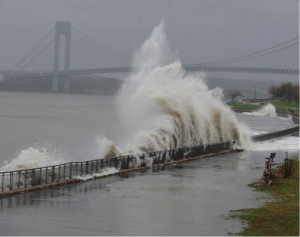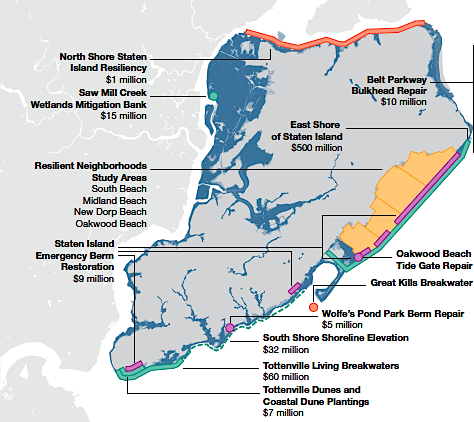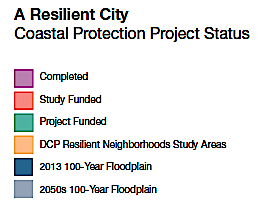
Attention all those “safe” from flooding . . .
In the wake of Hurricane Sandy in 2012, New York City has proactively initiated several projects to enhance the city’s resilience and protect its citizens from coastal flooding in the event of another Sandy-like storm. However, recent research suggests that the City’s coastal resilience projects may not be providing as much protection as initially intended.
What has the City done to enhance its resilience?
The City has based its projects on 2013 sea level rise projections by the Intergovernmental Panel on Climate Change (IPCC), and has rapidly constructed resilience structures around its 520 miles of coastline to mitigate damage during future flood events. The projects include beach nourishment, dune construction, elevated shorelines, and other surge barriers.
Some projects have already been completed, while others are currently underway–all of them bear a heavy cost. The City’s coastal protection plan totals $3.7 billion and is already about 50% funded.
Below are the five most expensive coastal protection projects:
- East Shore of Staten Island – $ 500 Million.
- East Side Coastal Resiliency – $ 335 Million.
- Red Hook Integrated Flood Protection System– $ 100 Million.
- Tottenville Living Breakwaters – $ 60 Million.
- Breezy Point Double Dunes – $58 Million.

Does this mean New York City residents are now protected from coastal flooding?
No, many New Yorkers who are set to be protected by these new structures may have a false sense of safety. Recent research has projected a more rapid sea level rise than that predicted previously by the IPPC. The IPCC projections indicate a potential 2-4 ft. increase by 2100, whereas new projections indicate a potential increase of 4-6 ft. by 2100. Since the coastal resilience infrastructure built in the years following Hurricane Sandy was designed on the projections of the IPCC, a key concern is: How long will post-Sandy resilience infrastructure will be effective?
But wait, these are results from only from one model, from one study. Isn’t the IPCC more credible?
Without question, the IPCC takes into account trends seen across multiple studies performed internationally; it is therefore more credible than a single study.
So what makes the projection in this study different from other similar studies?
The parameters of the model used in this recent study are what differentiate it from others of its kind. The model design has the ability to back source and account for the rate at which ice has melted in the past century, which then influences the model’s future projection of how fast ice will melt in coming years. By estimating the rate at which arctic ice will melt, sea-level rise can be estimated. Previous models were not able to include 20th century melting rates into their projections.
For this reason, the model used in this study has greater “clout” than others used to project sea level rise. Acknowledging that these are the results of one study, if additional research supports these projections, it would imply that many of the larger projects implemented so far in New York City may not be adequate to protect the City’s coastal zones.
Where do we go from here?
Due to the ongoing effects of climate change, sea level has been and is continuing to rise. Over the past century alone, the sea level surrounding New York City has risen over one foot. The rate at which it will continue to rise is uncertain and is heavily dependent on our actions as a global society. If this data is supported by future research, it will be crucial that New York City adjust both in-progress and completed resilience projects in anticipation of more rapid increases in sea level rise.
New Yorkers should question their safety from flooding, especially as the frequency of high-intensity storms is expected to increase. Residents should contact their local officials to ensure that their neighborhood is truly as protected as they believe it to be. A false sense of safety can lead to uniformed decision making and increased safety hazards. Is it vital that New Yorkers react now to avoid surprise in the face of disaster.


